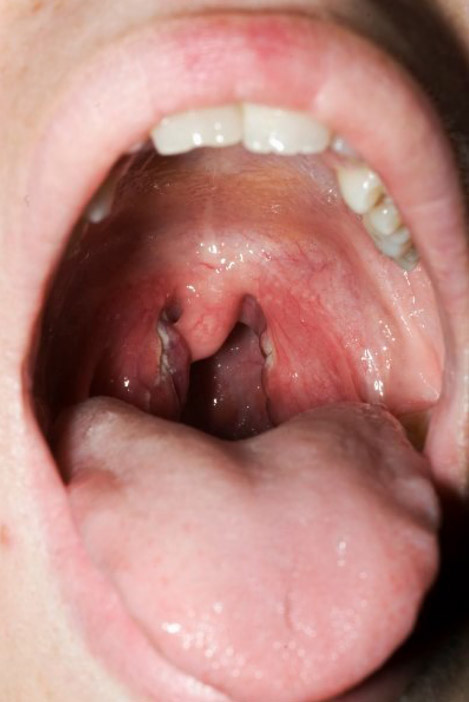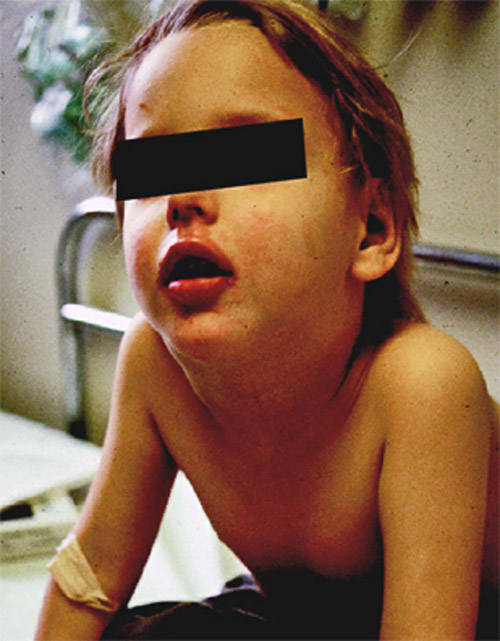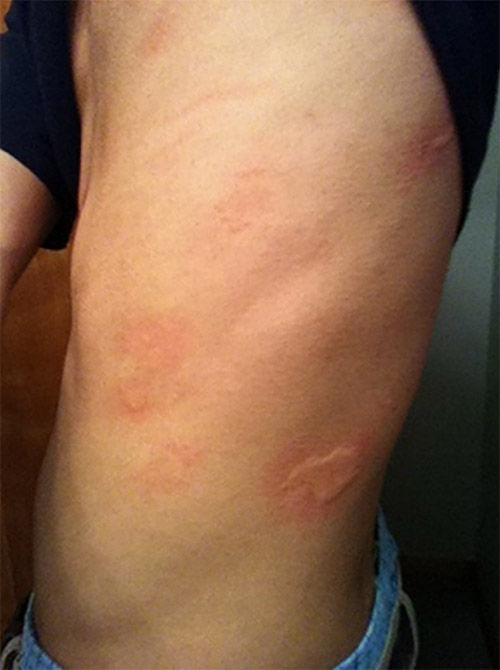Case 1 - Jarrah
- You are a clinician working in an emergency department in Queensland.
- You are about see a 6 year old Aboriginal male called Jarrah who was brought in by his father Jack and mother Sylvia. They tell you the reason they presented was that 'Jarrah was having difficulty breathing'.
- Observations: RR: 25 O2: 99% T: 37.8 HR: 115
- The history is notable for a 3 days of rhinorrhoea, cough and subjective fevers. He has no other infective symptoms. Jarrah’s oral intake was slightly reduced today.
- There were no relevant or concerning findings on perinatal history, developmental history, medical history, medications, allergies, vaccinations, family history, and social history.
- Jarrah appears well and was interactive, with no increased work of breathing and a clear chest on respiratory examination. He is well hydrated. The rest of the examination was unremarkable.
- You look in the back of Jarrah’s throat. You see an image similar to the below.

Questions to discuss about Jarrah’s case
- What is the most likely diagnosis?
- What is the most likely etiology for Jarrah’s presentation?
- What (if any) tests would you request?
- Would Jarrah be considered ‘high-risk’ for complications?
- What is the most appropriate management for Jarrah?
Normal range for vital signs by age
| Age | Heart rate (bpm) | Minimum Systolic BP (mmHg) | Respiratory Rate (bpm) |
|---|---|---|---|
| <1 year old | 100-159 | <75 | 21-45 |
| 1-4 year old | 90-139 | <80 | 16-35 |
| 5-11 year old | 80-129 | <85 | 16-30 |
| 12-17 year old | 60-119 | <90 | 16-25 |
Case 2 - Louise
- You are a clinician working in an emergency department in Queensland.
- You are about see a 9 month old female called Louise who was brought in by her father Andrew. They tell you the reason they presented was that 'Louise was having difficulty breathing'.
- Observations: RR: 35 O2: 100% T: 37.8 HR: 130
- The history is notable for a 3 days of rhinorrhoea, cough and subjective fevers. She woke up during the night with a barking cough, 'squeaking sound', and was 'working hard to breath'. Louise’s oral intake was normal today.
- There were no relevant or concerning findings on perinatal history, developmental history, medical history, medications, allergies, vaccinations, family history, and social history.
- Louise appears well, with no evidence of increased work of breathing. Louise intermittently coughs and you note it is barking in nature. You hear an abnormal breathing sound consistent with a stridor when Louise is active but not at rest. The chest was clear on respiratory examination. The rest of the examination is unremarkable.
- Refer to Module 5 - Stridor - case 2 to listen to audio of a similar presentation.
Questions to discuss about Louise’s case
- What is the most likely diagnosis? Consider the classic age and etiology of this condition.
- What differential diagnoses should you consider if Louise looked toxic?
- How would you classify the severity of Louise’s diagnosis?
- What are some risk factors for a severe presentation?
- What tests (if any) would you like to do?
- What would be your approach to her management? Consider mild, moderate, severe presentations.
Normal range for vital signs by age
| Age | Heart rate (bpm) | Minimum Systolic BP (mmHg) | Respiratory Rate (bpm) |
|---|---|---|---|
| <1 year old | 100-159 | <75 | 21-45 |
| 1-4 year old | 90-139 | <80 | 16-35 |
| 5-11 year old | 80-129 | <85 | 16-30 |
| 12-17 year old | 60-119 | <90 | 16-25 |
Case 3 - Geoff
- You are a clinician working in an emergency department in Queensland.
- You are about see a 9 month old male called Geoff who was brought in by his father Ben. They tell you the reason they presented was that 'Geoff was having difficulty breathing'.
- Observations: RR: 60 O2: 99% T: 40.1 HR: 210
- The history is notable for a 3 days of rhinorrhoea, cough and subjective fevers. He woke up during the night with a barking cough, 'squeaking sound', and was 'working hard to breath'. Geoff’s oral intake was normal today.
- There were no relevant or concerning findings on perinatal history, developmental history, medical history, medications, allergies, vaccinations, family history, and social history.
- Geoff appeared unwell and was not interactive. He had moderate subcostal and intercostal recessions with a soft stridor heard from the end of the bed. You notice Geoff was sitting with his trunk leaning forward, neck hyperextended, and chin thrust forward (see photo). The chest was clear on respiratory examination. The rest of the examination was unremarkable.
- You note that Geoff was sitting in a position similar to the image below:

Questions to discuss about Geoff’s case
- What is the differential diagnosis for an unwell/toxic child with stridor?
- What is the etiology for each of these differential diagnoses?
- What are symptom/signs that would make you suspect these diagnoses?
- How would you manage Geoff?
Normal range for vital signs by age
| Age | Heart rate (bpm) | Minimum Systolic BP (mmHg) | Respiratory Rate (bpm) |
|---|---|---|---|
| <1 year old | 100-159 | <75 | 21-45 |
| 1-4 year old | 90-139 | <80 | 16-35 |
| 5-11 year old | 80-129 | <85 | 16-30 |
| 12-17 year old | 60-119 | <90 | 16-25 |
Case 4 - Dennis
- You are a clinician working in an emergency department in Queensland.
- You are about see a 2 year old male called Dennis who was brought in by his mothers Tina and Monica. They tell you the reason they presented was that 'Dennis was having difficulty breathing'.
- Observations: RR: 25 O2: 99% T: 36.5 HR: 120
- The history is notable for coughing with some drooling. Dennis was playing in the adjacent play room whilst Tina was cooking dinner. Dennis proceeded to choke, and then suddenly started coughing with some drooling. He has no coryzal symptoms.
- There were no relevant or concerning findings on perinatal history, developmental history, medical history, medications, allergies, vaccinations, family history, and social history.
- Dennis appeared well and was interactive, with no increased work of breathing. He has a soft stridor heard from the end of the bed. There was a notable cough. The chest was clear on respiratory examination. The rest of the examination was unremarkable.
Questions to discuss about Dennis’s case
- What is the most likely diagnosis?
- What symptoms/signs are suggestive of this diagnosis?
- Which children are at higher risk?
- Where is the object most likely to lodge?
- Which (if any) tests should you request?
- What is your management approach for this condition? Consider potential complications.
Normal range for vital signs by age
| Age | Heart rate (bpm) | Minimum Systolic BP (mmHg) | Respiratory Rate (bpm) |
|---|---|---|---|
| <1 year old | 100-159 | <75 | 21-45 |
| 1-4 year old | 90-139 | <80 | 16-35 |
| 5-11 year old | 80-129 | <85 | 16-30 |
| 12-17 year old | 60-119 | <90 | 16-25 |
Case 5 - Layla
- You are a clinician working in an emergency department in Queensland.
- You are about see a 1 month old female called Layla who was brought in by her father Saeed and mother Aisha. They tell you the reason they presented was that 'Layla was having difficulty breathing'.
- Observations: RR: 50 O2: 99% T: 37.0 HR: 140
- The history is notable for a “squeaking sound” which had been noted since a few days of life. This has been somewhat worse in how loud it has been and this is the reason for presentation. It is loudest when feeding and sleeping and may disappear completely when crying. There is no history of coryzal symptoms. Layla’s oral intake was normal today.
- There were no relevant or concerning findings on perinatal history, developmental history, medical history, medications, allergies, vaccinations, family history, and social history.
- Layla appears comfortable. She has minimal subcostal and intercostal recessions with a low-pitched inspiratory stridor audible. The chest was clear on respiratory examination. The rest of the examination was unremarkable.
- Refer to Module 5 – Stridor - case 5 to view a video of a similar presentation.
Questions to discuss about Layla’s case
- What is the most likely diagnosis? Discuss other causes of congenital stridor.
- What are some other clinical features of this condition?
- What is the relationship between this condition and reflux?
- What further information would help you determine Layla’s management?
Normal range for vital signs by age
| Age | Heart rate (bpm) | Minimum Systolic BP (mmHg) | Respiratory Rate (bpm) |
|---|---|---|---|
| <1 year old | 100-159 | <75 | 21-45 |
| 1-4 year old | 90-139 | <80 | 16-35 |
| 5-11 year old | 80-129 | <85 | 16-30 |
| 12-17 year old | 60-119 | <90 | 16-25 |
Case 6 - Ahmed
- You are a clinician working in an emergency department in Queensland.
- You are about see a 1 year old male called Ahmed who was brought in by his father Tarek and mother Fatema. They tell you they reason they presented was that 'Ahmed was having difficulty breathing'.
- Observations: RR: 50 O2: 94% T: 37.0 HR: 160
- The history is notable for a rapid onset cough, widespread rash with increased work of breathing. The family were having dinner, and then Ahmed proceeded to start coughing, developed a 'squeaking sound', and a widespread rash. He was noted by his parents to be 'working hard to breath'. Ahmed’s oral intake was normal today.
- There were no relevant or concerning findings on perinatal history, developmental history, medical history, medications, allergies, vaccinations, family history, and social history.
- Ahmed appeared to be in some distress. He had moderate subcostal and intercostal recessions with a soft stridor heard from the end of the bed. There was a notable maculopapular rash throughout his body. His lips were swollen. The chest was clear on respiratory examination. The rest of the examination was unremarkable.
- The rash appeared similar to the image below:

Questions to discuss about Ahmed’s case
- What is the most likely diagnosis?
- What are some common causes/triggers for this?
- What are some risk factors for fatal anaphylaxis?
- What is required to meet the diagnosis of anaphylaxis (as opposed to a generalised allergic reaction)?
- How would you manage Ahmed?
- Any role for corticosteroids? Antihistamines? Salbutamol?
- When can you discharge Ahmed?
- What must be completed prior to discharge?
- Should you prescribe an EpiPen on discharge for a generalised allergic reaction to nuts?
Normal range for vital signs by age
| Age | Heart rate (bpm) | Minimum Systolic BP (mmHg) | Respiratory Rate (bpm) |
|---|---|---|---|
| <1 year old | 100-159 | <75 | 21-45 |
| 1-4 year old | 90-139 | <80 | 16-35 |
| 5-11 year old | 80-129 | <85 | 16-30 |
| 12-17 year old | 60-119 | <90 | 16-25 |